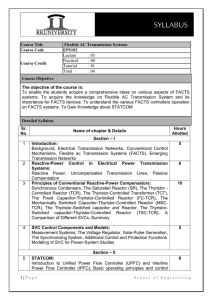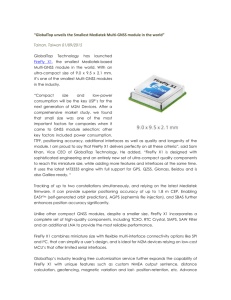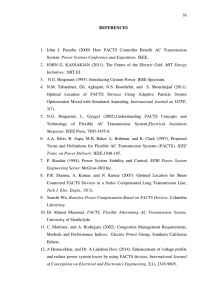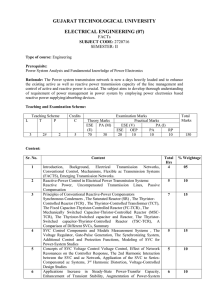TCSC placement for loss minimisation using self adaptive firefly
advertisement
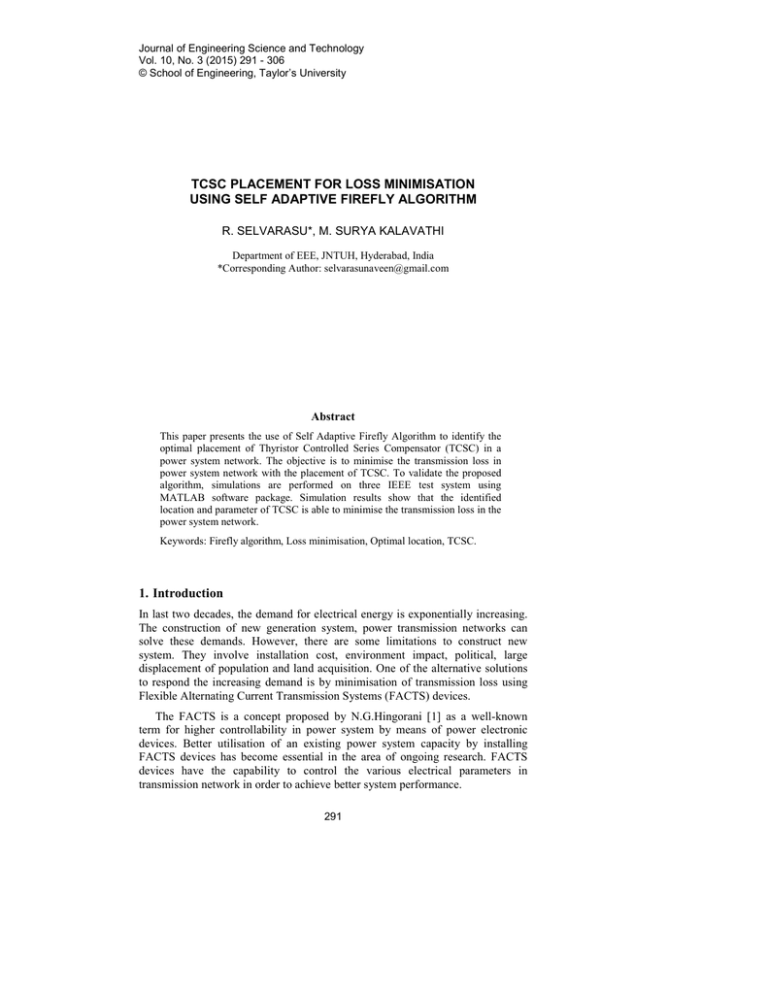
Journal of Engineering Science and Technology Vol. 10, No. 3 (2015) 291 - 306 © School of Engineering, Taylor’s University TCSC PLACEMENT FOR LOSS MINIMISATION USING SELF ADAPTIVE FIREFLY ALGORITHM R. SELVARASU*, M. SURYA KALAVATHI Department of EEE, JNTUH, Hyderabad, India *Corresponding Author: selvarasunaveen@gmail.com Abstract This paper presents the use of Self Adaptive Firefly Algorithm to identify the optimal placement of Thyristor Controlled Series Compensator (TCSC) in a power system network. The objective is to minimise the transmission loss in power system network with the placement of TCSC. To validate the proposed algorithm, simulations are performed on three IEEE test system using MATLAB software package. Simulation results show that the identified location and parameter of TCSC is able to minimise the transmission loss in the power system network. Keywords: Firefly algorithm, Loss minimisation, Optimal location, TCSC. 1. Introduction In last two decades, the demand for electrical energy is exponentially increasing. The construction of new generation system, power transmission networks can solve these demands. However, there are some limitations to construct new system. They involve installation cost, environment impact, political, large displacement of population and land acquisition. One of the alternative solutions to respond the increasing demand is by minimisation of transmission loss using Flexible Alternating Current Transmission Systems (FACTS) devices. The FACTS is a concept proposed by N.G.Hingorani [1] as a well-known term for higher controllability in power system by means of power electronic devices. Better utilisation of an existing power system capacity by installing FACTS devices has become essential in the area of ongoing research. FACTS devices have the capability to control the various electrical parameters in transmission network in order to achieve better system performance. 291 292 R. Selvarasu and M. S. Kalavathi Nomenclatures Gl Im k LM l M m,n nd PDi PGi Ploss QDi QGi QGimax QGimin rm,n Vi,Vj Conductance of lth line Light intensity of the mth firefly Number of iterations Line location of the mth TCSC Number of transmission of lines Maximum number of fireflies Number of fireflies Number of decision variables Real power drawn by the load at ith bus Real power generation at ith generator Total real power loss Reactive power drawn by the load at bus i Reactive power generation at ith generator Maximum reactive power generation of ith generator Minimum reactive power generation of ith generator Cartesian distance between mth and nth firefly Xline Reactance of the transmission line Voltage magnitudes at bus i and j respectively Greek Symbols α Random movement factor βm,n Attractiveness Parameter δij Voltage angle at bus i and j γ Absorption parameter γTCSC Compensation factor of the TCSC Abbreviations FA Firefly Algorithm SAFA Self Adaptive Firefly Algorithm TCSC Thyristor Controlled Series Compensator FACTS devices can be divided in to Shunt Connected, Series connected and combination of both [2]. The Static Var Compensator (SVC) and Static Synchronous Compensator (STATCOM) are belongs the shunt connected devices and are in use for a long time in various places. Consequently, they are variable shunt reactors which inject or absorb reactive power in order to control the voltage at a given bus [3].Both Thyristor Controlled Series Compensator (TCSC) and Static Synchronous Series Compensator (SSSC) are belongs to the series connected devices. The TCSC and SSSC mainly control the active power in a line by varying the line reactance. They are in operation at a few places but are still in the stage of development [4, 5]. Unified Power Flow Controller (UPFC) is belongs to Combination of Shunt and Series devices. UPFC is able to control active power, reactive power and voltage magnitude simultaneously or separately [6]. Journal of Engineering Science and Technology March 2015, Vol. 10(3) TCSC Placement for Loss Minimisation using Self Adaptive Firefly Algorithm 293 Optimal location of various types of FACTS devices in the power system has been experienced using different Meta-heuristic algorithm such as Genetic Algorithm (GA), Simulated annealing (SA), Ant Colony Optimisation (ACO), Bees Algorithms (BA), Differential Evolution (DE), and Particle Swarm Optimisation (PSO), etc. [7].Optimal locations of multi type FACTS devices in a power system to improve the loadability by means of Genetic Algorithm has been successfully implemented [8]. PSO has been applied to determine the optimal location of FACTS devices considering cost of installation [9]. PSO has been proposed to select the optimal location and setting parameter of SVC and TCSC to mitigate small signal oscillations in multi machine power system [10]. PSO has been proposed to improve the power system stability by determining the optimal location and controller design of STATCOM [11]. Bees Algorithm has been proposed to determine the optimal allocation of FACTS devices for maximising the available transfer capability [12]. Bacterial Foraging algorithm has been used to find the optimal location of UPFC devices with objectives of minimising the losses [13, 14]. Firefly Algorithm has been developed by Xin-She Yang [7, 15], it could handle multi modal problems of combinational and numerical optimisation more naturally and efficiently. It has been then applied by various researchers for solving various problems, to name a few: economic dispatch [16-18], fault identification [19], scheduling [20] and Unit commitment [21], etc. However, the improper choice of FA parameters affects the convergence and may lead to suboptimal solutions. There is thus a need for developing better strategies for optimally selecting the FA parameters with a view of obtaining the global best solution besides achieving better convergence. Self-Adaptive FA (SAFA) based strategies have been proposed to minimise the transmission loss through placing TCSCs [22] and UPFCs [23]. In this paper Self Adaptive Firefly Algorithm is proposed to identify the optimal location and parameter of TCSC, which minimises the transmission loss in the power system network. Simulations are performed on IEEE 14-bus IEEE 30-bus and IEEE 57-bus system using MATLAB software package. Simulations results are presented to demonstrate the effectiveness of the proposed approach. 2. TCSC Model The Thyristor Controlled Series Compensator (TCSC) is a capacitive reactance compensator. It consists of a series capacitor bank shunted by a thyristor controlled reactor in order to provide a smoothly variable series capacitive reactance [2]. The TCSC can be connected in series with the transmission line to compensate the inductive reactance of the transmission line. The reactance of the TCSC depends on its compensation ratio and the reactance of the transmission line where it is located. The model of TCSC is shown in Fig.1. The TCSC modelled by the reactance, XTCSC is given as follows X ij = X line + X TCSC (1) X TCSC = γ TCSC X line (2) Journal of Engineering Science and Technology March 2015, Vol. 10(3) 294 R. Selvarasu and M. S. Kalavathi Bus i Bus j XTCSC Xline Fig. 1. TCSC model. 3. Firefly Algorithm Firefly Algorithm is a recent nature inspired meta- heuristic algorithms which has been developed by Xin-She Yang at Cambridge University in 2007 [7]. The algorithm mimics the flashing behaviour of fireflies. This FA is similar to other optimisation algorithms employing swarm intelligence such as PSO. But Firefly Algorithm is found to have superior performance in many cases [9]. 3.1. Classical firefly algorithm It employs three ideal rules. First rule is all fireflies are unisex which means that one firefly will be attracted to other fireflies regardless of their sex. Second rule is the degree of the attractiveness of a firefly is proportional to its brightness, thus each firefly’s moves towards brighter one. More brightness means less distance between two fireflies. Though if any two flashing fireflies are having same brightness, then they move randomly. Final rule is the brightness of a firefly is determined by the value of the objective function. In case of maximisation problem, the brightness of each firefly is proportional to the value of the objective function. For a minimisation problem, the brightness of each firefly is inversely proportional to the value of the objective function. Firefly Algorithm initially produces a swarm of fireflies located randomly in the search space. Initial distribution is usually produced from a uniform random distribution and the position of each firefly in the search space represents a potential solution of the optimisation problem. Dimension of the search space is equal to the number of optimising parameters in the given problem. Fitness function takes the position of a firefly as input and produces a single numerical output denoting how good the potential solution is. Fitness value is assigned to each firefly. The brightness of each firefly depends on the fitness value of that firefly. Each one firefly is attracted by the brightness of other firefly and tries to move towards them. The velocity or the drag a firefly towards another firefly depends on the attractiveness. The attractiveness of firefly depends on the relative distance between the fireflies and it can be a function of the brightness of the fireflies as well. In each iterative step, Firefly Algorithm computes the brightness and the relative attractiveness of each firefly. Based on these values, the positions of the fireflies are updated. After a sufficient number of iterations, all fireflies will converge to the best possible position on the search space. The number of fireflies in the swarm is known as the population size, N. The selection of population size depends on the specific optimisation problem. Though, typically a population size of 20 to 50 is used for PSO and Firefly Algorithm for most applications [9, 17]. Each mth firefly is denoted by a vector xm as Journal of Engineering Science and Technology March 2015, Vol. 10(3) TCSC Placement for Loss Minimisation using Self Adaptive Firefly Algorithm 295 x m = [ x1m , x m2 ....... x mnd ] (3) The search space is limited by the following inequality constraints x (min) ≤ x v ≤ x v (max) , v = 1, 2......, nd v (4) Initially, the positions of the fireflies are generated from a uniform distribution using the following equation x mv = x v (min) + ( x v ( max) − x v ( min)) × rand (5) Here, rand is a random number between 0 and 1, taken from a uniform distribution. The initial distribution does not significantly affect the performance of the algorithm. Every time the algorithm is executed and the optimisation process starts with a different set of initial points. However, in each case, the algorithm searches for the optimum solution. In the case of multiple possible sets of solutions, the proposed algorithm may converge on different solutions each time. Although each of those solutions will be valid as they all will satisfy the requirement. The light intensity of the mth firefly, Im is given by Im =Fitness(xm) (6) th th The attractiveness between m and n firefly, βm,n is given by β m , n = ( β max, m , n − β min, m , n ) exp ( − γ m rm , n ) + β min, m , n 2 rm , n = x m − x n = (7) nd ∑ ( x mk − x nk ) 2 (8) v =1 The value of βmin is taken as 0.2 and the value of βmax is taken as 1. γ is another constant whose value is related to the dynamic range of the solution space. The position of firefly is updated in each iterative step. If the light intensity of nth firefly is larger than the light intensity of the mth firefly, then the mth firefly moves towards the nth firefly and its motion at kth iteration is denoted by the following equation: x m ( k ) = x m ( k − 1) + β m , n ( x n ( k − 1) − x m ( k − 1)) + α ( rand − 0.5) (9) The random movement factor α is a constant whose value depends on the dynamic range of the solution space. At each iterative step, the intensity and the attractiveness of each firefly is calculated. The intensity of each firefly is compared with all other fireflies and the positions of the fireflies are updated using Eq. (9). After an adequate number of iterations, each firefly converges to the same position in the search space and the global optimum is achieved. 3.2. Self-adaptive firefly algorithm In the above narrated FA, each firefly of the swarm travel around the problem space taking into account the results obtained by others and still applying its own randomised moves as well. The random movement factor (α) is very effective on the performance of Firefly Algorithm. A large value of α makes the movement to explore the solution through the distance search space and smaller value of α tends to facilitate local search. In this paper the random movement factor (α) is Journal of Engineering Science and Technology March 2015, Vol. 10(3) 296 R. Selvarasu and M. S. Kalavathi dynamically tuned in each iteration. The influence of other solutions is controlled by the value of attractiveness (7), which can be adjusted by modifying three parameters α, βmin, and γ. In general the value of βmax should be used from 0 to1 and two limiting cases can be defined: The algorithm performs cooperative local search with the brightest firefly strongly determining other fireflies positions, especially in its neighbourhood, when βmax = 1 and only non-cooperative distributed random search with βmax = 0. On the other hand, the value of γ determines the variation of attractiveness with increasing distance from communicated firefly. Setting γ as 0 corresponds to no variation or attractiveness is constant and conversely putting γ as ∞ results in attractiveness being close to zero which again is equivalent to the complete random search. In general γ in the range of 0 to 10 can be chosen for better performance. Indeed, the choice of these parameters affects the final solution and the convergence of the algorithm. Each firefly with nd decision variables in the Firefly Algorithm will be defined to encompass nd + 3.Firefly Algorithm variables in a self-adaptive method, where the last three variables represent αm, βmin and γm. A firefly can be represented as x m = [ x 1m , x m2 ....., x mnd , α m , β min, m , γ m ] (10) Each firefly possessing the solution vector, αm, βmin and γm undergo the whole search process. During iteration, the FA produces better off-springs through Eqs. (7) and (9) using the parameters available in the firefly of Eq. (10), thereby enhancing the convergence of the algorithm. The basic steps of the Firefly Algorithm can be summarised as the pseudo code which is depicted in Appendix A. 4. Problem Formulation To achieve the better utilisation of an existing power system, the optimal location and parameter of TCSC to be identified in the power transmission network to minimise the total real power loss. The objective of this paper is to identify the optimal location and parameter of the TCSC which minimise the real power loss. 4.1. Objective function The objective of this paper is to minimise transmission loss with the placement of TCSC in power system network, which can be evaluated from the power flow solution [13], and written as: nl Min Ploss = ∑ G1 ( Vi 2 + V j2 − 2ViV j cos δ ij ) (11) l =1 4.2. Problem constraints The equality constraints are the load flow equation given by PGi − PDi = Pi ( V ,δ ) (12) QGi − QDi = Qi ( V ,δ ) (13) Journal of Engineering Science and Technology March 2015, Vol. 10(3) TCSC Placement for Loss Minimisation using Self Adaptive Firefly Algorithm 297 Two inequality constraints are considered as follows: The first constraint includes reactive power generation at PV buses. QGi min ≤ QGi ≤ QGi max (14) The second constraint represents the rating of TCSC −0.8 X line ≤ X TCSC ≤ 0.2 X line p .u (15) The Self Adaptive firefly algorithm based optimal location of TCSC problem is defined as ( L1 , γ TCSC ,1 , α m , β min , m , γ m )....( Lm , γ TCSC ,m , α m , β min , m , γ m ).... x = ................................................( L N , γ TCSC , N , α N , β min , N , γ N ) (16) The Self Adaptive Firefly Algorithm searches for optimal solution by maximising light intensity Im, like fitness function in any other stochastic optimisation techniques. The light intensity function can be obtained by transforming the power loss function into Im function as Max I m = 1 / (1 + Ploss ) (17) A population of firefly is randomly generated and their intensity is calculated using Eq. (6). Based on the light intensity, each firefly moved to the optimal solution through Eq. (9) and the iterative process continues till the algorithm converges. The flow of the proposed FA based method is given through the flow chart of Appendix A. 5. Simulation Results and Discussions The effectiveness of the proposed Self Adaptive Firefly algorithm (SAFA) to identify the optimal location and parameter of the TCSC devices to minimise the transmission loss in the power system has been implemented and tested on IEEE 14-bus, IEEE 30-bus and IEEE 57-bus system using MATLAB 7.5. The line data and bus data for the three test systems are taken from [24]. The results of the SAFA are compared with that of the Honey Bee Optimisation Algorithm (HBOA) and Bacterial Foraging Optimisation Algorithm (BFOA). 5.1. Case 1: IEEE 14- bus system In this case IEEE 14- bus system has been considered to identify the optimal location and parameter of the TCSC to minimise the real power loss. IEEE 14- bus system has 20 transmission lines, five generator buses (bus no 1,2,3,6 and 8) and rests are load buses. Simulations are carried out for different number of TCSC without considering the installing cost. The simulation results in terms of the locations and the TCSC parameters and the resulting loss are presented in Table 1. It is observed from the Table 1 that the identified location of TCSC minimises the real power loss. When three TCSC is considered real power loss considerably reduced from 13.3663 MW to 13.2902 MW. If four TCSC is considered the real power loss reduction is insignificant from the installation cost point of view. But the HBOA and BFOA is able to reduce the losses only to 13.2931 MW and 13.2943 MW respectively for placing three TCSC devices. This lowest loss value indicates Journal of Engineering Science and Technology March 2015, Vol. 10(3) 298 R. Selvarasu and M. S. Kalavathi the superior performance of the proposed SAFA. However when another TCSC is added, the loss reduction is insignificant. It is thus concluded that three TCSC devices are adequate to achieve the desired goal of minimising the loss. The comparison of real power loss for IEEE 14 bus system is shown in Fig. 2.The convergence characteristics of SAFA for IEEE 14 bus system is shown in Fig. 3. Table 1. Optimal location, parameter of TCSC and real power loss for IEEE 14- bus system. No of TCSC 0 1 2 Proposed Method Real LM γ TCSC power ( p.u) loss (MW) 13.3663 13.3161 17 -0.800 17 -0.799 13.2915 15 -0.800 Honey Bee Real LM γ TCSC power (p.u) loss (MW) 13.3663 13.3163 17 -0.799 17 -0.800 13.2950 15 -0.663 3 13.2902 17 8 15 -0.800 -0.114 -0.800 13.2926 15 17 9 -0.690 -0.800 -0.304 4 13.2890 16 17 15 18 -0.798 -0.800 -0.799 -0.626 13.2931 18 17 9 15 -0.323 -0.800 -0.364 -0.656 Bacterial Foraging Real LM γ TCSC power (p.u) loss (MW) 13.3663 13.3168 17 -0.796 17 -0.800 13.3029 8 -0.415 -0.197 -0.800 8 -0.605 13.2933 17 15 13.2943 17 15 16 8 -0.800 -0.534 -0.124 -0.243 Fig. 2. Comparison of real power loss for IEEE 14 bus system. Fig. 3. Convergence characteristics of SAFA for IEEE 14 bus system. Journal of Engineering Science and Technology March 2015, Vol. 10(3) TCSC Placement for Loss Minimisation using Self Adaptive Firefly Algorithm 299 5.2. Case 2: IEEE 30- bus system In this case IEEE 30- bus system has been considered to identify the optimal location and parameter of the TCSC to minimise the real power loss. IEEE 30bus system has 41 transmission lines, six generator buses (bus no 1, 2, 5, 8, 11 and 13) and rests are load buses. Simulations are carried out for different number of TCSC without considering the installing cost. The simulation results in terms of the locations and the TCSC parameters and the resulting loss are presented in Table 2. It is observed from the Table 3 that the identified location of TCSC minimises the real power loss. When six TCSC is considered real power loss considerably reduced from 17.5028 MW to 17.4043 MW. But the HBOA and BFOA is able to reduce the losses only to 17.4098 MW and 17.4210 MW respectively for placing six TCSC devices. This lowest loss value indicates the superior performance of the proposed SAFA. It is thus concluded that six TCSC devices are adequate to achieve the desired goal of minimising the loss. The comparison of real power loss for IEEE 30 bus system is shown in Fig. 4.The convergence characteristics of SAFA for IEEE 30 bus system is shown in Fig. 5. Table 2. Optimal locations, parameter of TCSC and real power loss for IEEE 30- bus system. Proposed Method No of TCSC 0 3 4 5 6 Real power loss (MW) 17.5028 17.4343 17.4386 17.4332 17.4043 Honey Bee LM γ TCSC (p.u) - - 9 14 24 24 14 31 4 4 35 24 9 17 20 9 35 14 25 4 0.209 -0.800 -0.318 -0.259 -0.800 0.183 -0.550 -0.558 0.156 -0.224 0.200 0.187 -0.141 0.200 -0.367 -0.684 -0.035 -0.707 Real power loss (MW) 17.5028 17.4396 17.4394 17.4385 17.4098 Bacterial Foraging γ TCSC (p.u) Real power loss (MW) - - 17.5028 9 28 14 25 14 30 4 4 35 31 9 33 20 9 33 14 25 4 0.200 0.067 -0.632 -0.267 -0.788 0.174 -0.512 -0.383 -0.076 -0.278 0.200 0.168 LM -0.150 0.200 -0.617 -0.053 -0.759 17.4489 17.4479 17.4420 17.4210 γ TCSC LM (p.u) - - 14 4 35 25 14 29 4 14 4 17 29 34 21 9 32 14 26 4 -0.767 -0.357 -0.195 -0.042 -0.694 -0.014 -0.306 -0.720 -0.665 0.018 -0.402 -0.559 -0.185 0.163 -0.295 -0.572 -0.025 -0.786 Fig. 4. Comparison of real power loss for IEEE 30 bus system. Journal of Engineering Science and Technology March 2015, Vol. 10(3) 300 R. Selvarasu and M. S. Kalavathi Fig. 5. Convergence characteristics of SAFA for IEEE 30 bus system. 5.3. Case 3: IEEE 57- bus system The IEEE 57 bus system has 80 transmission lines and seven generator buses (bus no 1, 2, 3,6,8,9 and 12). Simulations are carried out for different number of TCSC without considering the installing cost. The simulation results in terms of the locations and the TCSC parameters and the resulting loss are presented in Table 3. It is observed from the Table 3 that the identified location of TCSC minimises the real power loss. When six TCSC is considered real power loss considerably reduced from 27.2233 MW to 26.9979 MW. But the HBOA and BFOA is able to reduce the losses only to 27.0034 MW and 27.0055 MW respectively for placing six TCSC devices. This lowest loss value indicates the superior performance of the proposed SAFA. However when another TCSC is added, the loss reduction is insignificant. It is thus concluded that six TCSC devices are adequate to achieve the desired goal of minimising the loss. The comparison of real power loss for IEEE 57 bus system is shown in Fig. 6.The convergence characteristics of SAFA for IEEE 57 bus system is shown in Fig. 7. Fig. 6. Comparison of real power loss for IEEE 57 bus system. Journal of Engineering Science and Technology March 2015, Vol. 10(3) TCSC Placement for Loss Minimisation using Self Adaptive Firefly Algorithm 301 Fig. 7. Convergence characteristics of SAFA for IEEE 57 bus system. Table 3. Optimal locations, parameter of TCSC and real power loss for IEEE 30- bus system. Proposed Method No of TCSC ( p.u) LM - - 27.2233 36 41 54 66 51 -0.434 -0.313 -0.528 -0.401 0.005 27.0135 73 36 41 54 66 51 52 73 36 41 54 66 51 0.032 -0.434 -0.313 -0.528 -0.401 0.005 -0.164 0.032 -0.434 -0.313 -0.528 -0.401 0.005 LM 0 27.2233 5 27.0007 26.9979 7 26.9985 γ TCSC Real Power Loss (MW) Real Power Loss (MW) 6 Honey Bee 27.0043 27.0034 Bacterial Foraging γ TCSC γ TCSC (p.u) Real Power Loss (MW) LM (p.u) - - 27.2233 - - 41 50 66 55 53 -0.288 -0.331 -0.428 -0.367 -0.293 27.0181 43 66 4 36 51 0.159 -0.408 0.120 -0.717 -0.054 41 31 55 48 43 66 51 40 35 41 54 66 52 -0.465 -0.220 -0.540 0.076 -0.408 -0.417 -0.186 0.027 -0.431 -0.291 -0.538 -0.388 -0.009 59 44 66 41 55 72 46 36 33 41 66 43 54 -0.070 0.011 -0.460 -0.452 -0.266 0.095 -0.199 -0.226 -0.442 -0.549 -0.380 -0.556 -0.348 27.0071 27.0055 5.4. Parameter of the Adaptive Firefly Algorithm The population size N for three IEEE test system are taken as 30. The maximum number of Iterations considered as 200. The random movement factor α are tuned during each iteration. The initial value of α is set to 0.5. The attractiveness parameter β is varied from βmin to βmax. The value of βmin is taken as 0.2 and the value of βmax is taken as 1. The absorption parameter γ is taken as 1 and it is tuned in all iteration. It has to be pointed out that the performance of the entire metaheuristic optimisation algorithm is very dependent on the tuning of their different parameters. A small change in the parameter may result in a large change in the Journal of Engineering Science and Technology March 2015, Vol. 10(3) 302 R. Selvarasu and M. S. Kalavathi solution of these algorithms. Self adaptive Firefly Algorithm is a powerful algorithm which efficiently tuned all the parameters to obtain the global or near global optimal solution. It is very clear from the above discussions that the proposed SAFA is able to reduce to the loss to the lowest possible by optimally placing and determining the parameters when compared to other optimisation algorithms. In addition the selfadaptive nature of the algorithm avoids repeated runs for fixing the optimal FA parameters by a trial and error procedure and provides the best possible parameters values. 6. Conclusion The optimal location of FACTS devices play a vital role in achieving the proper functioning of these devices. However this paper made an attempt to identify the optimal location and parameter of TCSC which minimises the transmission loss in the power system network using Self Adaptive Firefly algorithm. Simulations results are presented for IEEE14-bus IEEE30- bus and IEEE57- bus systems. Results have shown that the identified location of TCSC minimise the transmission loss in the power system network. With the above proposed algorithm it is possible for utility to place TCSC devices in transmission network such that proper planning and operation can be achieved with minimum system losses. References 1. 2. 3. 4. 5. 6. 7. 8. 9. Hingorani, N.G.; and Gyugyi, I. (2000). Understanding FACTS: concepts and technology of flexible AC transmission systems. IEEE Press, New York. Mathur, R.M.; and Varma, R.K. (2002). Thyristor-based FACTS Controllers for Electrical Transmission Systems. Piscataway: IEEE Press. Ambriz-perez, H.; Acha, E.; and Fuerte-Esquivel, C.R. (2000). Advanced SVC models for Newton Raphson load flow and Newton optimal power flow studies. IEEE Transaction on Power System, 15(1), 129-136. Orfanogianni, T. (2000). A flexible software environment for steady state power flow optimisation with series FACTS devices. DSc Tech Diss, ETH, Zurich. Larsen, E.V.; Clark, K.; Miske, S.A.; and Urbanek, J. (1994). Characteristic and rating considerations of thyristor controlled series compensation. IEEE Transactions on Power Delivery, 9(2), 992-1000. Gyugyi, L. (1992). Unified power flow controller concept for flexible AC transmission system. IEE proceedings, 139(4), 323-331. Yang, X.S. (2010). Nature-Inspired Meta-Heuristic Algorithm. Beckington, Luniver Press. Gerbex, S.; Cherkaom, R.; and Germond, A.J. (2001). Optimal location of multi type FACTS devices in a power systems by means of genetic algorithms. IEEE Transaction on Power System,16(3), 537-544. Saravanan, M.; Mary, R.S.S.; Venkatesh, P.; and Abraham, J.P.S. (2007). Application of particle swarm optimisation technique for optimal location of Journal of Engineering Science and Technology March 2015, Vol. 10(3) TCSC Placement for Loss Minimisation using Self Adaptive Firefly Algorithm 10. 11. 12. 13. 14. 15. 16. 17. 18. 19. 20. 21. 22. 303 FACTS devices considering cost of installation and system loadability. Electrical Power Systems Research, 77(3-4), 276-283. Mondal, D.; Chakrabarti, A.; and Sengupta, A. (2012). Optimal placement and parameter setting of SVC and TCSC using PSO to mitigate small signal stability problem. International Journal of Electrical Power & Energy Systems, 42(1), 334-340. Siddhartha, P.; and Narayana, P.P. (2008). Optimal location and controller design of STATCOM for power system stability improvement using PSO. Journal of the Franklin Institute, 345(2), 166-181. Mohamid, I.R.; Khairuddin, A.; and Mustafa, M.W. (2009). Optimal allocation of FACTS devices for ATC enhancement using Bees algorithm. World Academy of science Engineering and Technology, 3, 313-320. Tripathy, M.; and Mishra, S. (2007). Bacteria foraging based solution to optimize both real power loss and voltage stability limit. IEEE Transactions on Power System, 22(1), 240-248. Senthil, K.M.; and Renuga, P. (2012). Application of UPFC for enhancement of voltage profile and minimisation of losses using fast Voltage stability index (FVSI). Archives of Electrical Engineering Journal, 61(2), 239-250. Yang, X.S. (2009). Firefly algorithms for multimodal optimisation, Stochastic algorithms: Foundations and applications. SAGA 2009, LNCS, Berlin, Germany: Springer-Verlag, 5792, 169-178. Apostolopoulos, T.; and Vlachos, A. (2011). Application of the Firefly Algorithm for solving the economic emissions load dispatch problem. International Journal of Combinatorics, 2011(523806), 23. Taher, N.; Rasoul, A.A.; and Alireza, R. (2012). Reserve constrained dynamic economic dispatch: A new fast self-adaptive modified firefly algorithm. IEEE System Journal, 6(4), 635-646. Yang, X.S.; Hosseini, S.S.; and Gandomi, A.H. (2012). Firefly algorithm for solving non-convex economic dispatch problems with valve loading effect. Applied Soft Computing, 12(3), 180-186. Falcon, R.; Almeida, M.; and Nayak, A. (2011). Fault identification with binary adaptive fireflies in parallel and distributed systems. Proceedings of IEEE Congress on Evolutionary Computation, 359-1366. Chandrasekaran, K.; and Simon, S.P. (2011). Demand response scheduling in SCUC problem for solar integrated thermal system using firefly algorithm. Proceedings of IET Conference on Renewable Power Generation (RPG 2011), 1-8. Chandrasekaran, K.; and Simon, S.P. (2012). Network and reliability Constrained unit commitment problem using binary real coded Firefly Algorithm. International Journal of Electrical Power and Energy Systems, 43(1), 921–932. Selvarasu, R, and Christober, A.R.C. (2013) Self Adaptive Firefly Algorithm based transmission loss minimisation using TCSC. In Proceedings of International Conference on Advanced Nanomaterials and Emerging Engineering Technologies, 683-688. Journal of Engineering Science and Technology March 2015, Vol. 10(3) 304 R. Selvarasu and M. S. Kalavathi 23. Selvarasu, R; and Surya, K.M. (2013) Optimal placement of UPFC for voltage constrained loss minimisation using self-adaptive Firefly Algorithm. International Review of Electrical Engineering, 8(4), 1296-1301. 24. University of Washington. (2012). Power systems test case archive. Retrieved May 5, 2012 from http://www.ee.washington.edu/research/pstca/ Journal of Engineering Science and Technology March 2015, Vol. 10(3) TCSC Placement for Loss Minimisation using Self Adaptive Firefly Algorithm 305 Appendix A Figures and their Captions Read the Power System Data Select the population size N and Maximum number of Iterations for convergence check Generate the initial population while (termination requirements are not met) do for m=1:N Alter the system data α, βmin, and γ according to mth firefly values Run the load flow Compute the Real power loss Calculate Im For n =1: N Alter the system data according to nth firefly values Run the load flow Compute the Real power loss Calculate Im If Im < In Compute γm,n using (8) Evaluate β m,n using (7) Move mth firefly towards nth firefly through (9) end if end for n end for m, Rank the fireflies and find the current best End while End Fig. A-1. Pseudo Code of Firefly Algorithm. Journal of Engineering Science and Technology March 2015, Vol. 10(3) 306 R. Selvarasu and M. S. Kalavathi Start A Read power system data Choose FA parameters such as population size, Iter max, α, βmin and γ Calculate the transmission loss and compute light intensity In using equation (6) No K=0 Is Im < In Generate initial population and location of fireflies Yes th for m=1:N B Move m firefly towards nth firefly using equation (9) n Place the TCSC according to mth fireflies K= k+1 Obtain the values for α, βmin, and r from mth fireflies for n=1:N B No Is k > Iter max Run the load flow Calculate the transmission loss and compute light intensity Im using (6) m Yes Optimal solution is reached. The fire fly with largest light intensity is the optimal solution Place the TCSC according to nth fireflies Print the results Stop Run the load flow A Fig. A-2. Flow Chart of the Self Adaptive FA. Journal of Engineering Science and Technology March 2015, Vol. 10(3)

